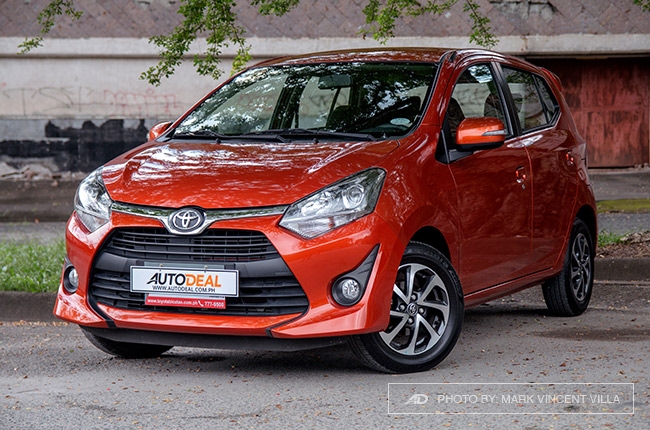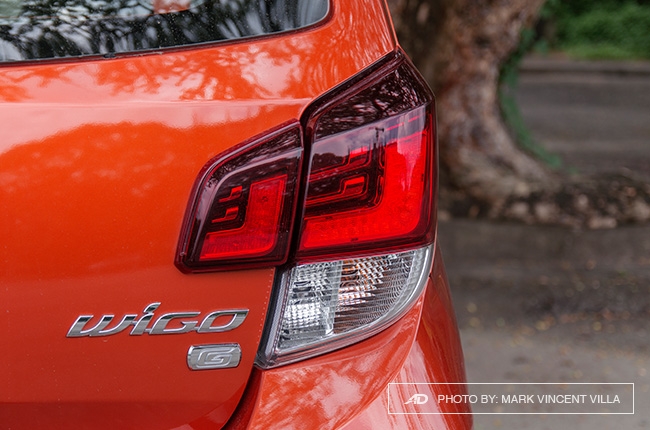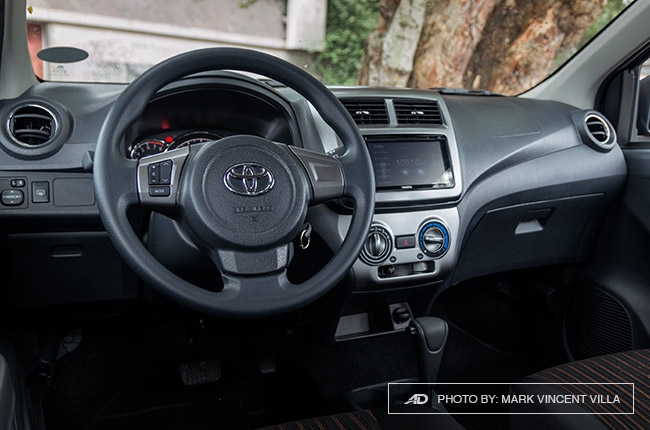
The Toyota Wigo arrived in the Philippines last 2014 and since then, it has managed to become one of the best-selling cars in the country. Why so? The Wigo offered a number of factors that made it an ideal choice for Filipino car buyers.
Similar to other mini subcompact hatch, the Wigo’s size is an ideal carriage in the congested urban jungle. Another factor could be its 1.0L engine, which relatively delivers a more frugal fuel economy. Third is its P600,000 less price tag and Toyota’s reputation in the country, which is the number 1 car brand in the local market.
As such, Toyota Motor Philippines (TMP) intends to maintain its positive sales performance by launching the refreshed Wigo. In order to find out if it can maintain the momentum of the outgoing model, TMP handed us the keys of the range-topping 2017 Wigo.
Engine Output (HP), Acceleration, Transmission, Handling 3.5/5
Exterior & Interior Design, Quality, Fit and Finish, Ergonomics 4.0/5
Cabin Comfort, Suspension, NVH Insulation 3.5/5
Convenience Technologies, Active and Passive Safety Features 3.5/5
Amount of the vehicle you get for the price, Fuel Efficiency 4.0/5
- Fuel efficient 1.0L gasoline engine.
- Stylish exterior.
- Instrument cluster has gear indicator.
- Cabin acoustics could be improved.
- Touchscreen infotainment is a tad slow to respond.
- Hard to connect mobile phone via Bluetooth.
At first glance, it’s easy to spot the design changes that are integrated to the refreshed Wigo. The new look is more aggressive and striking as compared to its predecessor. The front gets a redesigned bumper, a revamped grille, a restyled hood, sharp-looking headlights, and fog lamps that give the Wigo a smiling face. I personally like the Wigo’s grille, which is larger than the old model. This does not only give the vehicle added style points but, it also makes the Wigo look bigger and more composed.
Turning at the side, Toyota’s mini subcompact hatch looks the same except for the updated alloy wheels and mirror-mounted turn signals. The rear, on the other hand, comes with distinctive taillights that has a black outline, an angular bumper, and a spoiler. Overall, we find the Wigo’s exterior better than the outgoing model.
Inside, the Wigo gets minor but significant design changes. It has a black interior theme with silver accents and orange stitching found on the seats. One of the updates fitted to this car is the new instrument cluster, which now includes a gear indicator. This allows you to easily see which gear are you on without the need of looking down at the actual shifter. The center console is also redesigned, which now comes with 2, rather than 3, circular air conditioner controls. The Wigo is also equipped with driver and front passenger airbags.
Moreover, the touchscreen infotainment system is given a refresh, which we find to be sleeker and give a more upmarket feel. However, we find it hard to connect our mobile phones to the infotainment system via Bluetooth. Of note, Toyota could have done more in regards to the Wigo’s interior. Unlike its exterior, the vehicle’s cabin didn’t have much of a change.
In terms of interior space, this Wigo can easily accommodate 4 adult occupants that fall under the typical Filipino height of 5’5”. The leg- and head-room for rear passengers are adequate but fitting 3 full grown adults at the back seat could be a bit difficult. The Wigo also has ample trunk space. You can fit up to 5 regular backpacks with room for more.
Under the hood, the 2017 Wigo is still powered by a 1.0L gasoline engine but, Toyota has integrated it with its Variable Timing Intelligence (VVT-I) technology. As a result, the Wigo gets a slight increase in power (+1 hp and +4 Nm) bringing its power output rating up to 66 hp and 89 Nm of torque.

The Wigo is easy to drive in the congested urban jungle. Its diminutive dimension is perfect to keep up with Waze’s navigational skills, which is fond of letting you pass through tight streets. The steering wheel is a bit heavy considering its size but, it gives you more control when turning. In terms of ride comfort, this Wigo can absorb road imperfections better than its predecessor however, don’t expect it to have an Altis- or a Camry-like ride. After all, this is a P600K-less car. Fuel economy-wise, it registered 9.6 km/l while driving around the city with an average speed of 40 km/h.
Out on the open highway, this Wigo is surprisingly stable. Again, the relatively heavy steering wheel plays to your advantage when you’re driving at highway speeds. This, in turn, gives you more control and confidence while driving on the expressway. In terms of acceleration, the Wigo’s 1.0L engine takes time to gain speed but, once you reached your desired highway speed it becomes stable. The downside for this Wigo is its cabin acoustics. Tire and wind noise is audible when driving on the expressway. However, we can let this one pass since it yielded 22 km/l while driving at an average speed of 90 km/h in NLEX. Talk about fuel efficiency – the Wigo has it.
As a whole, we can say the 2017 Wigo is still one of the strongest contender in the tightly contested mini subcompact hatch segment. With its new exterior look, added features, and a price tag of P599,000, the Wigo is indeed an attractive choice when you’re on the look-out for small cars that could take on your daily city drive and out-of-town weekend trips.
Specifications
Engine
1.0 LFuel Type
GasolinePerformance
65 hp @ 6,000 rpmTransmission
Automatic-
Summary
-
Name Toyota Wigo 1.0 G AT Body Type Hatchback Price ₱684,000 Transmission Category Automatic -
Engine
-
Engine Size 1.0 L Displacement 998 cc Number of Cylinders 3 Number of Valves 12 Transmission Type 4-Speed Automatic -
Performance
-
Drivetrain Front-Wheel Drive Max Output (hp) 65 hp @ 6,000 rpm Max Torque (nm) 89 Nm @ 4,400 rpm -
Economy & Environment
-
Fuel Type Gasoline Emissions Standard n/a Fuel Capacity 33.0 L Combined Fuel Consumption n/a -
Dimensions
-
Length 3,660 mm Width 1,600 mm Height 1,520 mm Wheelbase 2,450 mm Turning Circle 5 m Ground Clearance 180 mm Trunk Capacity n/a Number of Doors 5 Number of Seats 5 -
Safety & Security
-
Driver's Airbag 1 Front Passenger's Airbag 1 Side Airbag Curtain Airbag Knee Airbag Auto Brake System Electronic Brake Distribution Anti-lock Brake System (ABS) Anti-Lock Brake System
Immobilizer Security Alarm Stability Control Electronic Door Locks Speed Sensing Door Locks ISOFIX Lane Departure Warning System Blind-Spot Detection System -
Features
-
Cruise Control Front Parking Sensors Rear Parking Sensors Leather Upholstery Push Start Button Wheel Size 14 in Wheels Metal Type Alloy Airconditioning System LCD Air Conditioner Panel Entertainment System 7-inch touchscreen Audio AM/FM Connectivity USB/ AUX and Blue Tooth Navigation Ready Warranty 3 Years (100,000 km) Keyless Entry Roof Rack Sunroof Electric Adjustable Seats Power Steering Power Windows Power Outlet Steering Wheel Audio Control -
Technology
-
Active Park Assist Hill Start Assist AWD Modes n/a Tire Pressure Monitoring Heads-up Display Power Liftgate Start-stop System
Colors
Latest Review
-
Addictively excessive: The Ford Ranger Raptor Twin Turbo V6 / Review
The Ford Ranger Raptor Twin Turbo V6 is one crazy pickup truck. Wondering why? Just keep reading.
4.6 / 5 -
The Kia Carnival gives you more: More seats, more comfort, and more practicality / Review
The Kia Carnival is a three-row MPV designed for executives and families. It combines comfort, technology, and practicality, making it a strong choice for those looking for a premium people...
4.2 / 5 -
The Jetour Ice Cream: A pint-sized EV that’s hard to ignore / Review
The Jetour Ice Cream is an adorable, pint-sized electric car that’s made for the city. Affordable and stylish, it’s easy to love, but does it tick all the boxes for you?
3.7 / 5
Popular Articles
-
Cheapest cars under P700,000 in the Philippines
Jerome Tresvalles · Sep 02, 2024
-
First car or next car, the Ford EcoSport is a tough package to beat
Jun 18, 2021
-
Car Maintenance checklist and guide – here’s everything you need to know
Earl Lee · Jan 12, 2021
-
Most fuel efficient family cars in the Philippines
Bryan Aaron Rivera · Nov 27, 2020
-
2021 Geely Okavango — Everything you need to know
Joey Deriquito · Nov 19, 2020
-
Family cars in the Philippines with the biggest trunks
Sep 20, 2023
-
Head to head: Toyota Rush vs. Suzuki XL7
Joey Deriquito · Oct 28, 2020
-
Why oil changes are important for your car
Earl Lee · Nov 10, 2020
-
2021 Kia Stonic — What you need to know about it
Joey Deriquito · Oct 16, 2020
-
Top 7 tips for buying a used car in the Philippines
Joey Deriquito · Nov 26, 2020






















